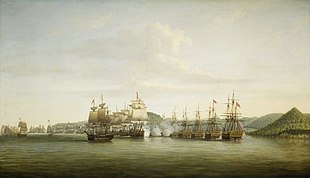The Capture of St Lucia or the Battle of Morne de la Vierge was a battle fought on the island of St. Lucia in the West Indies during the American War of Independence between 18 and 28 December 1778, between British and French forces. The British landed on St. Lucia and defeated a French landing force that had come to reinforce the garrison. The island then capitulated.
Background[]
On 7 September 1778, the French governor of Martinique, the Marquis de Bouille, surprised and captured the British island of Dominica. On 4 November, French Admiral Jean Baptiste Charles Henri Hector Comte d'Estaing sailed for the West Indies from the port of Boston. On that same day, Commodore William Hotham was dispatched from Sandy Hook, New York, to reinforce the British fleet in the West Indies. Hotham sailed with "five men of war, a bomb vessel, some frigates, and a large convoy."[1] The convoy Hotham was escorting consisted of 59 transports carrying 5,000 British soldiers under Major General Grant.[2] The French fleet was blown off course by a violent storm, preventing it from arriving in the Caribbean ahead of the British. Admiral Samuel Barrington, the British naval commander stationed on the Leeward Islands, joined the newly arrived Commodore Hotham on 10 December at the island of Barbados. Grant's men were not permitted to disembark and spent the next several days aboard their transports. Barrington and Hotham sailed for the island of St. Lucia on the morning of 12 December.
Invasion[]
On the evening of 13 December and morning of 14 December, Major General James Grant,[3] supported by additional troops under Brigadier General William Medows[4] and Brigadier General Robert Prescott,[5] landed at Grand Cul de Sac, St. Lucia. Grant and Prescott took control of the high ground around the bay, while Medows continued on and took Vigie the following morning (14 December). Also on the same day the invaders marched upon the capital of Castries, and the fort of Morne Fortuné, which the French governor, Claude Anne Guy de Micoud, evacuated without a fight. The French decided it best to retire into the jungle, allowing Grant to occupy the Carénage Bay, three miles north of Cul de Sac, without losses and by the evening of 14 December. That evening the French fleet under d'Estaing arrived, forcing Admiral Barrington to move his ships into line of battle and abandon his plan to bring the transports into the bay.[1]
Battle of Morne de la Vierge[]

December 15, 1778. The 12 French ships of Estaing (left) attacking seven English ships of Admiral Barrington (right).
On 18 December 1778, a force of 9,000 French troops was landed on St. Lucia. The small British force of 1,400 men occupied a hill located on the neck of a peninsula, known as Cul de Sac. The French were fairly raw soldiers, trained to fight in the classic European style of linear battles. They advanced on the British force several times. The British, particularly the 5th Regiment of Foot, were veterans of colonial fighting. They inflicted a stinging defeat on the French, who lost 400 killed and 1100 wounded; British losses were only 10 killed and 130 wounded. With the defeat of d'Estaing on 15 December and therefore the loss of all hope of reinforcement, the French garrison surrendered on 28 December. The imminent arrival of British reinforcements under John Byron forced the French to reembark their remaining troops during the night of 28–29 December, returning to Martinique by 30 December.[6]
Aftermath[]
St. Lucia became a crucial base for the British fleet for the rest of the war in the Lesser Antilles, providing a critical resupply point used in battles such as the crushing defeat of French naval power at the Battle of the Saintes in 1782 at the hands of Admiral Rodney. The British held the island until 3 January 1784, providing a good bargaining chip during negotiations with the French over the fate of other islands seized from Britain during the war in the Caribbean, such as Dominica. After the battle, the 5th Foot took the white plumes worn by the French soldiers and wore them as battle trophies. Later on, these plumes became the standard part of the uniform for the regiment.
References[]
- ↑ 1.0 1.1 Ekins, Charles. The Naval Battles of Great Britain: From the Accession of the Illustrious House of Hanover to the Throne to the Battle of Navarin. Baldwin and Cradock, 1828; p. 91.
- ↑ Ekins, p. 93.
- ↑ Jaques, Tony. Dictionary of Battles and Sieges: A Guide to 8,500 Battles from Antiquity Through the 21st-century. Greenwood Publishing Group, 2007; pp. 882. ISBN 978-0-313-33536-5.
- ↑ Cunningham, George Godfrey. A History of England in the Lives of Englishmen. A. Fullarton, 1853; pp. 133.
- ↑ Wilson, James Grant, and John Fiske. Appleton's Cyclopaedia of American Biography. D. Appleton, 1900; pp. 5:109.
- ↑ Marly p.319.
Bibliography[]
- Appleton, D Appleton's Cyclopaedia of American Biography. ,
- Jaques, Tony Dictionary of Battles and Sieges: A-E Greenwood 2006 ISBN 978-0-313-33536-5
- Marley, F. David. Wars of the Americas: A Chronology of Armed Conflict in the New World, 1492 to the Present ABC-CLIO (1998). ISBN 0-87436-837-5
The original article can be found at Capture of St. Lucia and the edit history here.
